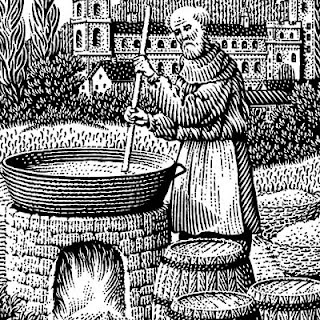 |
| Hops are a "bine", using their strong stems and stiff hairs to climb. |
While some may think of hops as an ingredient that has always been
around in the brewing process of beer, but the truth couldn't be more
different. Hops are a fairly new addition to the process. Before hops were
around, a mixture of herbs and spices called gruit was used. This mixture
consisted of such spices like bog myrtle, St. John's wort, coriander, rosemary,
yarrow, alecost, along with many others. This mixture of herbs and spices was
not only chosen for flavor profile but also for medicinal purposes also. These
mixtures were often kept secret (their exact ingredients and measurement) by
the Catholic Church. Because of this secrecy, the Protestant movement helped
drive the popularity of hops in the brewing process. Using the hops in their
process allowed these brewers to get free of the fees and taxes that came with
using the gruit. While hops are now quite a popular ingredient in beer, this
was not always the case.
 |
| Old-World Brewing Illustration |
When the use of hops first came
around, it did not have a lot of appeal with the populous. In fact, Henry VIII
once condemned hops as an adulteration and that a law that forbid their use in
brewing should be created. Hops did not start out with quite a good reputation.
However, they did bring some benefits to the industry that changed the minds of
people around the world.
Brewers figured out that their "hopped beer" could stay in
storage longer. This became influential in one of the most popular brews in the
craft industry, the I.P.A. Standing for Indian Pale Ale, this brew was crafted
with a whole lot of hops. This made it last the trip on the trading route from
Eastern Europe to India, allowing sailors to have something to drink that would
not spoil on the trip. Before this was found, it was generally thought that the
stronger (higher alcohol) the beer was
the longer that it took before it spoiled. Now, sailors could have a drink that
wouldn't get them drunk so quickly or spoil on the ride. The beer could be a
lower alcohol content and keep the whole trip. The chemical make-up of the hop
really allowed for a whole new thinking in the brewing industry.
Hops, while adding the preservative properties to beer, also added
flavors and aromas to beer that made it much more different from gruit. These
two additions come from the resins (called lupulin) that are produced on the
leaves of the hops. There are two types of resins: alpha and beta. The alpha
and beta resins give the beer it's flavor and aroma. These impart the "hop
character" that beers have.
As well as adding flavor and shelf longevity, hops also made it so that
beer held a proper "head retention." The head of a beer is really
where one gets the aroma that the beer gives off. This is the first impression
of a beer that someone will have. The head also has eye appeal, often times
lending itself to being a quality beer if it has and holds a proper head.
 |
| The head of the beer captures the aromas. |
Going from being the hated new kid to one of the most prominent
ingredients in a beverage that is a global commodity, hops are now an essential
to any beer. Depending when they are added to the brew, they can add flavor,
aroma, or both. Different hop varieties bring their own characteristics to the
table, allowing today's brewers to experiment with an age-long formula. It is
all in part to hops that we are now able to enjoy such a tasty beverage.
Whether you are a hop-head and love the really hoppy brews, or not, you cannot
like beer and not like hops. After all, where would beer be today without hops?
Have a hoppy beer that you enjoy? We would love to hear what it is!
No comments:
Post a Comment
We would love to hear from you!